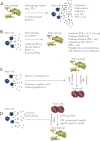Emerging role of mast cells and macrophages in cardiovascular and metabolic diseases
- PMID: 22240242
- PMCID: PMC3365842
- DOI: 10.1210/er.2011-0013
Emerging role of mast cells and macrophages in cardiovascular and metabolic diseases
Abstract
Mast cells are essential in allergic immune responses. Recent discoveries have revealed their direct participation in cardiovascular diseases and metabolic disorders. Although more sophisticated mechanisms are still unknown, data from animal studies suggest that mast cells act similarly to macrophages and other inflammatory cells and contribute to human diseases through cell-cell interactions and the release of proinflammatory cytokines, chemokines, and proteases to induce inflammatory cell recruitment, cell apoptosis, angiogenesis, and matrix protein remodeling. Reduced cardiovascular complications and improved metabolic symptoms in animals receiving over-the-counter antiallergy medications that stabilize mast cells open another era of mast cell biology and bring new hope to human patients suffering from these conditions.
Copyright © 2012 by The Endocrine Society
Figures







References
-
- Galli SJ, Kalesnikoff J, Grimbaldeston MA, Piliponsky AM, Williams CM, Tsai M. 2005. Mast cells as “tunable” effector and immunoregulatory cells: recent advances. Annu Rev Immunol 23:749–786 - PubMed
-
- Haley KJ, Lilly CM, Yang JH, Feng Y, Kennedy SP, Turi TG, Thompson JF, Sukhova GH, Libby P, Lee RT. 2000. Overexpression of eotaxin and the CCR3 receptor in human atherosclerosis: using genomic technology to identify a potential novel pathway of vascular inflammation. Circulation 102:2185–2189 - PubMed
Publication types
MeSH terms
Grants and funding
LinkOut - more resources
Full Text Sources
Medical

